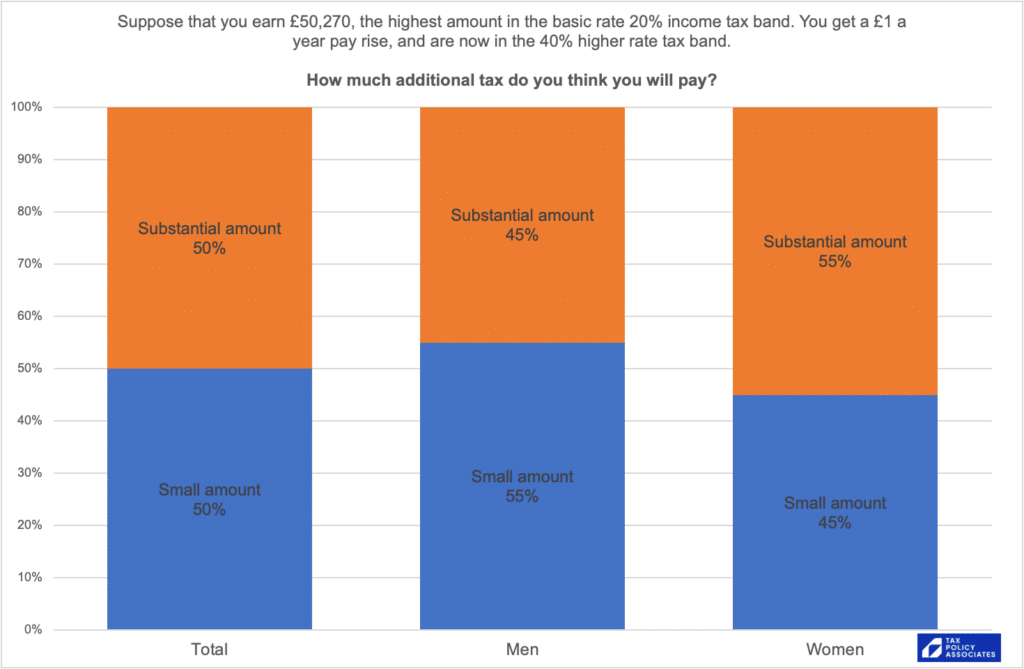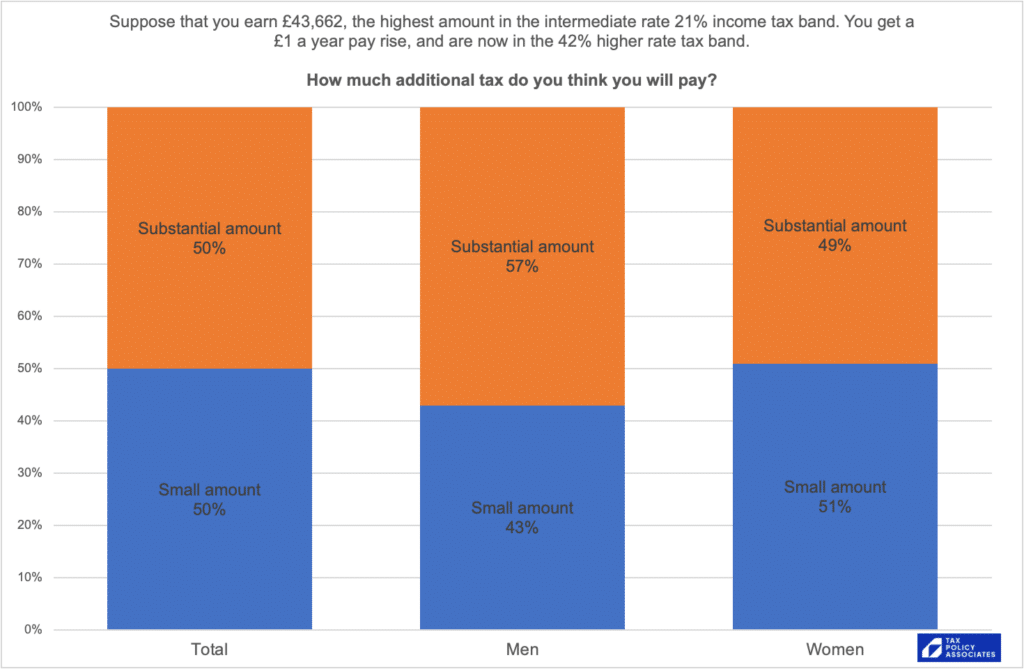New polling evidence from Tax Policy Associates and WeThink shows that half the public doesn’t understand a basic principle of income tax: the way that tax rates apply to income above a threshold. Our polling suggests that 50% of people believe that, once you hit the higher rate threshold, the 40% higher rate applies to all your earnings.
UPDATE October 2024 – we ran a new poll with completely different wording, testing the same point. The results were consistent.
If you live in England1, earn £50,269, and get a £1 pay rise, you’ll pay an additional 28p in tax – 20% income tax and 8% national insurance.
The £50,270 you’re now earning puts you at the top of the basic rate tax band. Get another £1 pay rise and you’re now in the higher rate tax band – and you’ll pay an additional 42p in tax – 40% income tax and 2% national insurance.2
The important thing is that the higher 40% rate applies only to your income above the £50,270 40% threshold. But it’s often suggested that many people don’t appreciate this, and think that the 40% applies to all your income – so that the £1 pay raise results in a massive additional tax bill.3 That is a very significant misunderstanding – but how common is it really?4
I was surprised at the results when I tested this with a Twitter poll:

This should be taken as nothing more than entertainment – Twitter polls are useless as a measure of public opinion.5 Thanks to WeThink, we can now do rather better.
The polling evidence
WeThink kindly included this issue as part of their regular opinion polling (they polled 1,164 people, before weighting).
Our question was:
“Suppose that you earn £50,270, the highest amount in the basic rate 20% income tax band. You get a £1 a year pay rise, and are now in the 40% higher rate tax band. How much additional tax do you think you will pay?”
The options we gave were:
- “a small amount of extra tax”, or
- “a substantial amount of extra tax”6
I think it’s clear that the correct answer is “a small amount”.7 But 50% of the public doesn’t agree:

What about supporters of different political parties?
Given their very different demographics we might expect to see different results. We don’t:8

Scotland
The Scottish rates are different. There is a 21% “intermediate rate” income tax band for earnings up to £43,662, and then a 42% “higher rate” tax band.
But the level of public understanding is almost identical:

How does the result vary with income, education, etc?
One obvious response to his data is to say that, as only a small proportion of the country pays the higher rate, it stands to reason that only a small proportion understand it.
If that were really what’s going on then we’d see a wide variation across polling subgroups, with higher awareness of the correct position amongst graduates, people living in London, and others who statistically are more likely to earn £50k. But we don’t see this at all in the data – the 50-50 breakdown is true across almost all the subgroups.
That said, we don’t right now have enough data to say this definitively – many of the subgroups are too small for statistical validity. So WeThink have kindly agreed to run some more polling so we can get enough data to do proper justice to the question, look in detail at the subgroups, and test the question by reference to income levels.
We’ll be returning to this issue soon.
Why is this important?
It used to be that only a small number of people paid higher rate tax – that is no longer the case. By 2027/28, the IFS has estimated 14% of adults will be in this tax band, which equates to about a quarter of all individual income taxpayers. It’s reasonable to expect that about half of all households will include someone paying higher rate tax at some point in their lifetime. So the higher rate is more important than it ever was.
Our poll findings shouldn’t cause concern that people are paying the wrong amount of tax. Employees are paid by PAYE, which deducts the correct tax automatically. The self employed either use HMRC’s self assessment system (which calculates the tax due) or use an accountant.
There are, however, other potential consequences of a widespread misunderstanding as to how income tax works.
First, and perhaps most importantly, there are anecdotal reports of people turning away work because they believe entering the higher rate tax band will cost them large amounts of money. If that’s true for even a small percentage of the population, then it’s a problem for the individuals in question and the country as a whole. We’d suggest it’s something that HMRC and policymakers should investigate. (We are unlikely to be able to look into this ourselves with further polling, due to the statistical limits of polling samples.)
Second, it would be sensible to assume that other basic tax concepts are equally misunderstood. Policymakers, media and others communicating about tax (including Tax Policy Associates) should try to bear this in mind.
Finally, it means that we should be careful when looking at opinion polling on tax questions: the responses may be based upon fundamental misunderstandings of the question.
Many thanks to Brian Cooper and Mike Gray at WeThink/Omnisis for their generosity in running polls for us pro bono. They ask for nothing in return, and don’t even ask to be credited.
Photo by Mika Baumeister on Unsplash
Footnotes
or Wales or Northern Ireland ↩︎
It used to be slightly more because of the High Income Child Benefit charge, but that’s now moved from £50k to £60k. However that doesn’t change the point of this article – the additional tax is still less than the £1 of additional earnings ↩︎
In other words, a marginal tax rate of over 100%. There are some points in our income tax system where that actually happens, but not here. And stamp duty land tax used to work in this way. ↩︎
A similar misconception used to exist regarding the Lib Dem policy in the 1990s and 2000s of putting a penny on income tax to increase funding for education. It was often said that many voters believed this meant exactly 1p more tax, rather than a 1% increase in the rate of income tax. I dimly recall there may have been an opinion poll confirming that this was a widespread belief, but I can’t find it now, and the story may be more myth than reality. ↩︎
i.e. because Twitter is not an accurate reflection of the population, my followers on Twitter are not an accurate reflection of Twitter users, and people clicking on the poll weren’t an accurate reflection of my followers. Twitter polls are fun, but are mostly useless. There is an excellent explainer on this here. ↩︎
Note that we forced people to make a choice, and didn’t provide a “not sure” option. The question of whether “forced choice” is the best approach has a long history… I have no expertise in this, and was happy to be guided by the experts at WeThink. ↩︎
Depending on how you read the question, the additional tax might be 14p, 20p, 40p, or 42p – but I don’t think that matters.. the amount is “small” in each case. The only exception is if you have significant savings, due to the loss of £500 personal savings allowance you’re a higher rate payer. For someone with around £12,000 of savings outside an ISA that could mean the £1 tax increase costs them £200 (£500 x 40%). ↩︎
The Lib Dem result is subject to larger uncertainties given the smaller number of respondents – there’s no statistically significant difference between the Lib Dem result and the Labour/Tory result. ↩︎


Leave a Reply to Dan Cancel reply